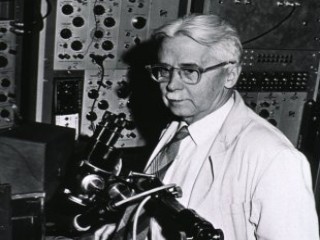
Haldan K. Hartline biography
Date of birth : 1903-12-22
Date of death : 1983-03-17
Birthplace : Bloomsburg,Pennsylvania,U.S.
Nationality : American
Category : Science and Technology
Last modified : 2011-12-20
Credited as : Physiologist, Physiology of the retina, Nobel laureate
0 votes so far
Hartline began his study of retinal electrophysiology as a National Research Council Fellow at Johns Hopkins University, Baltimore, receiving his M.D. in 1927. After attending the universities of Leipzig and Munich as an Eldridge Johnson traveling research scholar from the University of Pennsylvania, he returned to the United States to take a position in the Eldridge Reeves Johnson Foundation for Medical Physics at Penn, which was under the directorship of Detlev W. Bronk at that time. In 1940-1941 he was Associate Professor of Physiology at Cornell Medical College in New York City, but returned to Penn and stayed until 1949.
Then he became professor of biophysics and chairman of the department at Johns Hopkins in 1949. One of Hartline's graduate students at Johns Hopkins, Paul Greengard, later also won the Nobel Prize. Hartline joined the staff of Rockefeller University, New York City, in 1953 as professor of neurophysiology.
Hartline spent decades studying the optic nerves of frogs and horseshoe crabs. Working with Columbia University physiologist Clarence H. Graham, he was the first scientist to isolate and record of the activity of a single optic nerve fiber. He later showed that different fibers in the optic nerves respond to light in different ways.
For his research on cellular-level electrical activity within the eye, Hartline was awarded the Nobel Prize in Medicine in 1967, shared with Ragnar Granit and George Wald. He always preferred to be called by his middle name, Keffer, and upon winning his Nobel honors, Dr Hartline said he was "not very comfortable about all the fuss."
















